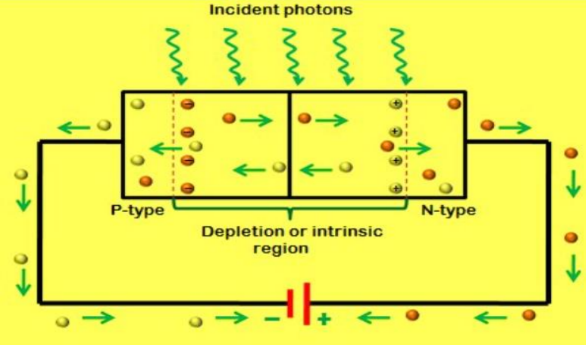
Open-Source Internship opportunity by OpenGenus for programmers. Apply now.
- Optoelectronics is the communication of optics and electronics which involves the study, design and manufacturing of hardware device which converts electrical energy into light and light into energy through semiconductors.
- Made up of semiconductor materials.
- Used in Military services, telecommunications,automatic access control systems and medical equipments.
Types of Optoelectronic devices
- LED
- Photo diode
- Photo transistor
Light Emitting Diode(LED)
- PN- Junction opto-semiconductor
- Emits monochromatic light when operated in forward bais condition
- Converts electrical energy to light energy
Operation
- When sufficient voltage is applied to the leads of the LED, electrons move in one direction across the junction between the p and n regions.
- The electrons recombine with the holes within the device.
- Release energy in the form of photons.
- This effect is called electroluminescence.

Advantages of LED
- Consumes less power
- Produces less heat
- Last longer than incandescent lamps
Disadvantages of LED
- Costly
- Temperature sensitivity
- Voltage sensitivity
Application of LED
- Mobile applications
- LED signals
- Automative uses
- Illumination
- Indicators
Photo Diode
- Light sensor made up of semiconductor materials
- When light falls on the junction, voltage or current is generated
- PN- Junction diode, operated in reverse bais
- When a photon(light) strikes a semiconductor, electron- hole pairs are generated through band-band optical absorption
- Electric field is produced when the electron diffuse into the junction
- This electric field across the depletion region is equal to the negative voltage across the unbaised diode. This is known as inner photoelectric effect
Operation
- Optical energy(light) is converted to electrical energy(current/voltage) through optical receivers.
- Refered to as O/E Converter.
- Photodector is the fundamental element of optical receivers.

Advantages of Photo diode
- Cost efficient
- Light weight and compact in size
- Wide spectral response
- Quick responce when exposed to light
Disadvantages of Photo diode
- Low illumination levels due to reverse current
- Temperature dependent
Applications of photodiode
- Fire and smoke detectors
- Photo sensors in camera
- Dectectors for computed tomography
- Blood gas monitors
Photo transistor
- Similar to bipolar junction transistor(BJT)
- Only difference is that base current is produced and controlled by light except voltage source
- Converts light energy to electrical signal
- Light sensitive
- Have collector, base and emitter
Operation
- Light sensitive collector base pn junction controls current flow between emitter and collector
- Resistance decreases as intensity increases, creating more emitter-base current
- The small base current controls the larger emitter-collector current
Advantages of Photo transistor
- More sensitive than photodiodes of comparable size
- Produce higher current than photodiodes
- Fast response, compact enough to fit onto single integrated computer chip
Disadvantages of Photo Transistor
- Silicon phototransistors cannot handle voltages above 1000V.
- More susceptible to electricity surges
Applications of Photo Transistor
- Lighting control(Roads,highways,etc.)
- IR Detectors
- Counting systems
- Security systems
